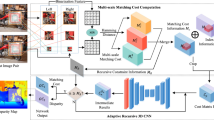Abstract
Stereo-matching is a hot topic in the field of visual image research, to address the low image-matching accuracy of traditional algorithms. In this paper, an optimization for image stereo-matching algorithm using deep reinforcement learning (DRL) is proposed in rule constraints and parallax estimation. First, the image edge pixel constraint rules are established, and the image sample blocks are adjusted. Second, the image parallax estimation is performed by computing geometric constraint and pixel parallax probability in rule constraints, and a DRL structure is designed. Finally, the DRL analysis is performed iteratively by the convolutional neural networks feature extraction, agent training decision, and reward value accumulation, and stereo-matching images are output. Experiments show that the image structural similarity of the proposed algorithm is high, and the correct matching rate is more than 95%. The images have good interpretability, and the stereo-matching effect is good.







Similar content being viewed by others
Data availability
The data used to support the findings of this study are available from the corresponding author upon request.
References
Zhang H, Li H, Wang Z et al (2020) Geometry and context guided refinement for stereo matching. IET Image Proc 14(12):2652–2659
Deng Y, Xiao J, Zhou SZ et al (2021) Detail preserving coarse-to-fine matching for stereo matching and optical flow. IEEE Trans Image Process 3(99):1–10
Zhu C, Chang YZ (2020) Stereo matching for infrared images using guided filtering weighted by exponential moving average. IET Image Proc 14(5):830–837
Jin Y, Zhao H, Bu P (2021) Spatial milree filter for cost aggregation in stereo matching. IET Image Proc 15(10):56–66
Kautz E, Ma W, Jana S et al (2020) An image-driven machine learning approach to kinetic modeling of a discontinuous precipitation reaction. Mater Charact 166:110379
Chatterjee J, Bhattacharyya R, Maulik A et al (2021) Application of Machine Learning on sequential de-convolution and convolution techniques for analysis of images from nuclear track detectors (NTDs). Radiat Meas 144(11):106581
Ziatdinov M, Jesse S, Sumpter BG et al (2020) Tracking atomic structure evolution during directed electron beam induced Si-atom motion in graphene via deep machine learning. Nanotechnology 32(3):1–6
Koktzoglou I, Huang R, Ankenbrandt WJ et al (2021) Super-resolution head and neck MRA using deep machine learning. Magn Reson Med 86(1):335–345
Nguyen HT, Barat C, Ducottet C (2014) Approximate image-matching using strings of bag-of-visual words representation. Int Conf Comput Vision Theory Appl (VISAPP) 2014:345–353
Wang L, Li Y, Huang J, Lazebnik S (2019) Learning two-branch neural networks for image-text matching tasks. IEEE Trans Pattern Anal Mach Intell 41(2):394–407
Cui S, Ma A, Wan Y, Zhong Y, Luo B, Xu M (2022) Cross-modality image matching network with modality-invariant feature representation for airborne-ground thermal infrared and visible datasets. IEEE Trans Geosci Remote Sens 60:1–14
Zheng X, Tao Y, Zhang R et al (2021) TimNet: a text-image-matching network integrating multi-stage feature extraction with multi-scale metrics. Neurocomputing 465(20):540–548
Hossein-Nejad Z, Agahi H, Mahmoodzadeh A (2021) Image-matching based on the adaptive redundant keypoint elimination method in the SIFT algorithm. Pattern Anal Appl 24(2):669–683
Wei H, Meng L (2023) An accurate stereo matching method based on color segments and edges. Pattern Recogn 133:108996
Zhou RG, Liu DQ (2019) Quantum image edge extraction based on improved sobel operator. Int J Theor Phys 58(9):1–17
Ren U, Nobukawa T, Miura M et al (2020) Dense parallax image acquisition method using single-pixel imaging for integral photography. Opt Lett 45(1):25–30
Yan XA, QHW B, Hui RA et al (2019) Optical arbitrary-depth refocusing for large-depth scene in integral imaging display based on reprojected parallax image. Optics Commun 433:209–214
Jiao L, Qian W, Qian C et al (2014) An efficient stereo matching method based on Bayesian theory. Laser Optoelectron Progress 51(10):69–76
Li J, Wang J, Wang X et al (2020) Evaluation and comparison of the results of the NET-VISA seismic event association method based on Bayesian theory. Nat Hazards 171(1):1521–1539
Manchella K, Umrawal AK, Aggarwal V (2021) FlexPool: a distributed model-free deep reinforcement learning algorithm for joint passengers and goods transportation. IEEE Trans Intell Transp Syst 3(99):1–13
Xie Y, Zhao X (2021) Sloshing suppression with active controlled baffles through deep reinforcement learning–expert demonstrations–behavior cloning process. Phys Fluids 33(1):017115
Vereng SS, Dong TN, Hamre G (2021) Dynamic positioning using deep reinforcement learning. Ocean Eng 235(3):109433
Msfba B, Sika B (2021) Deep reinforcement learning control of hydraulic fracturing. Comput Chem Eng 154(4):107489
Gao Y, Mosalam KM (2020) PEER hub imagenet: a large-scale multiattribute benchmark data set of structural images. J Struct Eng 146(10):04020198
Ibrahem H, Salem A, Kang HS (2021) Real-time weakly supervised object detection using center-of-features localization. IEEE Access 23(9):1–10
Funding
This work was supported by Natural Science Foundation of Heilongjiang Province of China under grant number LH2021F040.
Author information
Authors and Affiliations
Corresponding author
Ethics declarations
Conflict of interest
The authors declare no conflict of interest. No conflict of interest exits in the submission of this manuscript, and manuscript is approved by all authors for publication.
Additional information
Publisher's Note
Springer Nature remains neutral with regard to jurisdictional claims in published maps and institutional affiliations.
Rights and permissions
Springer Nature or its licensor (e.g. a society or other partner) holds exclusive rights to this article under a publishing agreement with the author(s) or other rightsholder(s); author self-archiving of the accepted manuscript version of this article is solely governed by the terms of such publishing agreement and applicable law.
About this article
Cite this article
Ren, J., Guan, F., Li, X. et al. Optimization for image stereo-matching using deep reinforcement learning in rule constraints and parallax estimation. Neural Comput & Applic 35, 24701–24711 (2023). https://doi.org/10.1007/s00521-023-08227-3
Received:
Accepted:
Published:
Issue Date:
DOI: https://doi.org/10.1007/s00521-023-08227-3




